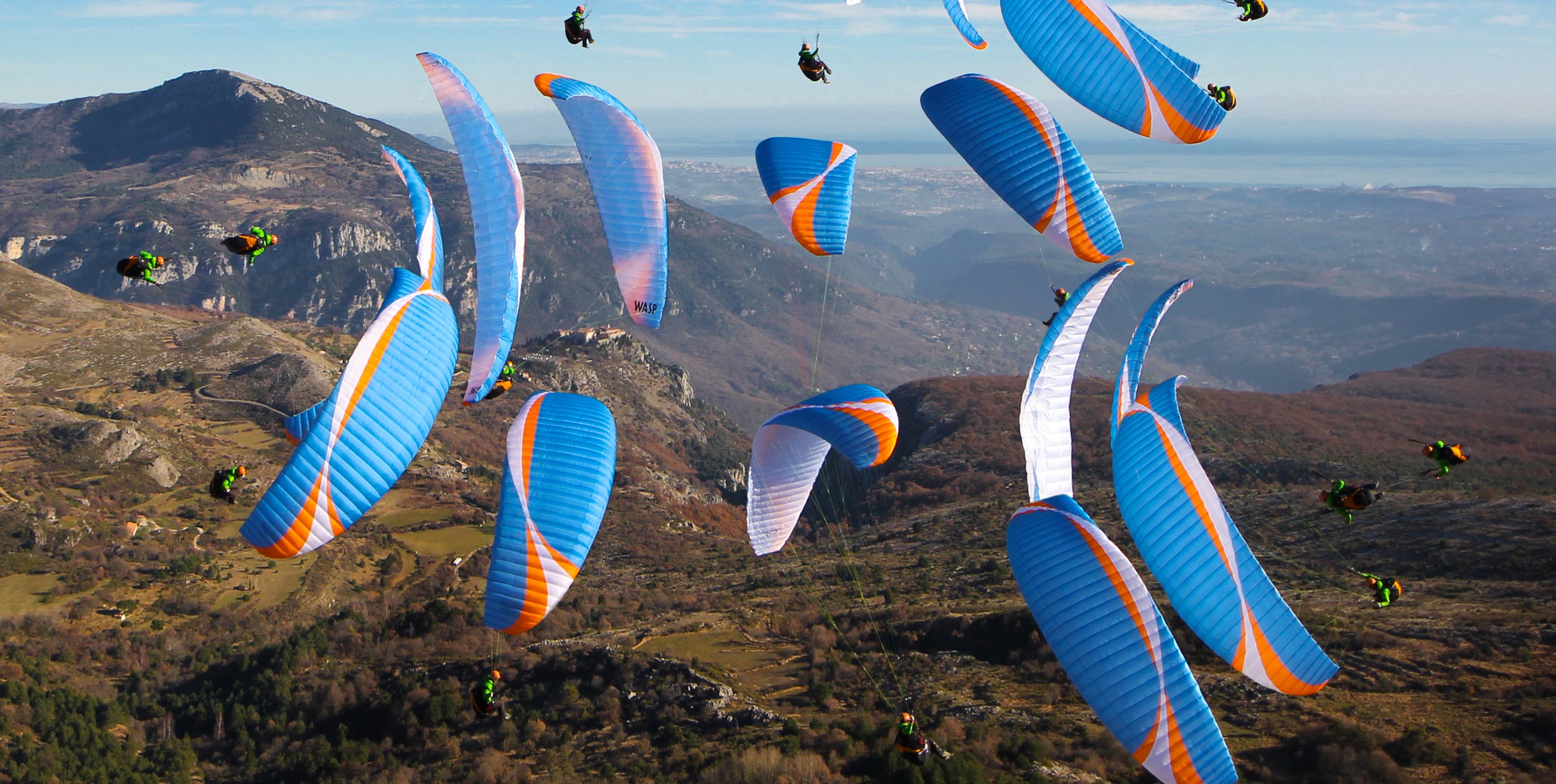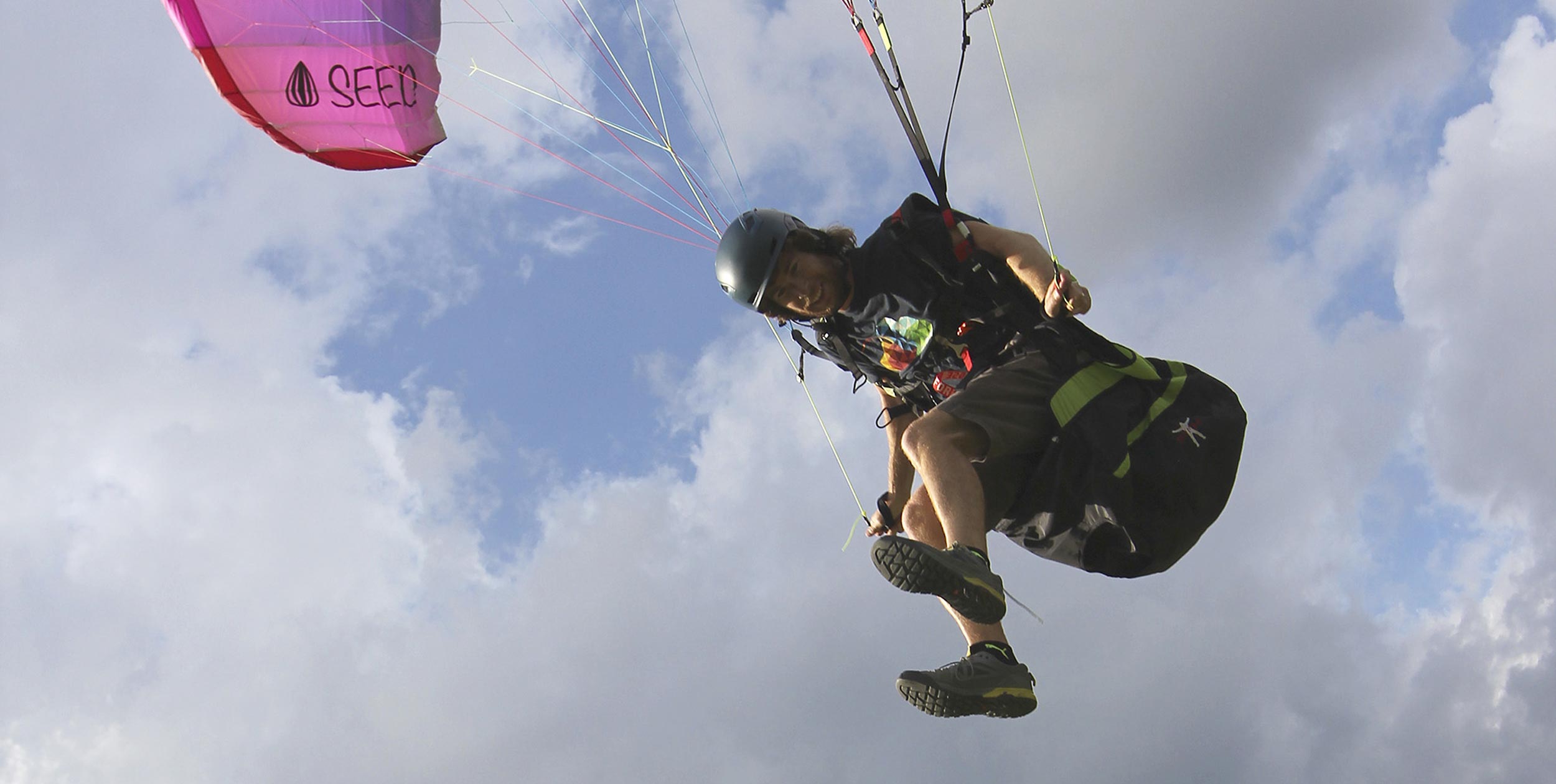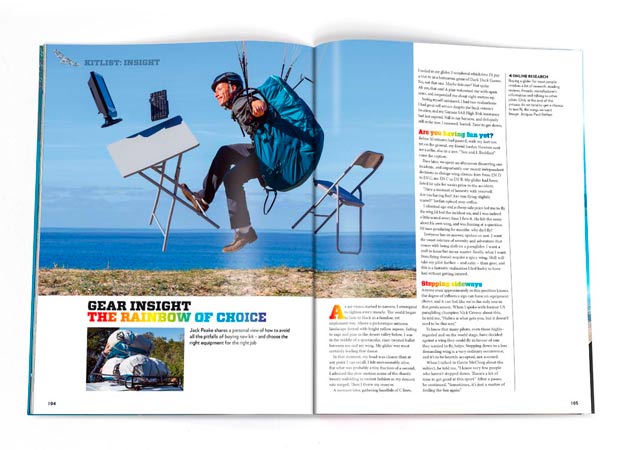Cross Country columnist Bruce Goldsmith gives his personal view on the latest technological development to sweep the paragliding world. A designer’s perspective. First published in April 2001
A Bit of History
Few ideas are really new in the world of paragliding, and partially closed leading edges is for sure not one of them. The first time I saw a glider with a partly closed leading edge was in 1993. The glider was Czech made I believe and it had every other cell closed across the whole of the span. I remember the pilot saying he had problems inflating it, which did not surprise me, and since then the concept has been pretty quiet.
However, there has been an increasing tendency amongst designers to close more and more tip cells over the years. In 1990, most gliders only had 2 cells completely closed at the tip. The number of closed tip cells has been increasing and I believe the Nova Argon for instance has 8 completely closed cells at each tip.
The problem with closing more cells than this is that when the glider collapses, the part of the glider with closed cells cannot collapse, and instead stays inflated. If this inflated section gets caught in the loose lines then this cause huge drag to build up, which can result in violent turning after a collapse, or spiraling, or even cravates. This is why the limit on the number of completely closed tip cells seems to have been reached.
Re-awakening
The concept re-emerged in spring 2000 when Advance released some Omega 5 competition protos with partly closed cells distributed across the whole span. In the hands of Andy Hediger, one of these protos won the PWC in 2000 and, not surprisingly, this sparked new interest amongst designers in closed leading edge cells. Nobody could possibly confirm how much of the glider’s success could be attributed to the closed leading edge, but it certainly did no harm and everyone seemed to agree that they looked very nice.
Why closed cells?
There is no doubt that, as long as it is inflated properly, a closed cell is aerodynamically cleaner than an open cell. If the cell is cleaner it should have less drag, resulting in better performance and more stability.
However its not as easy as simply closing half or even one third of all the cells. There are a few technical problems to overcome when designing closed cell gliders. Firstly, there is the take-off inflation problem encountered by our Czech friend all those years ago: if you start closing more of the leading edge it gets increasingly difficult to get enough air into the glider to inflate it quickly enough, especially in the centre of the wing. The second problem is achieving the transfer of the leading edge spanwise tension across the closed cell.
Different Variations
It is interesting to see the different ways manufacturers have solved these problems in their new partially closed leading edge designs.
The Omega 5 from Advance features semi-circular openings where all the span wise tension in the leading edge stays along the top of the opening. In order to have a few more open cells to get enough air into the glider on inflation, there are a few closed cells omitted in strategic places, especially in the center of the wing which helps to get enough air into the wing on inflation.
Then there is the Edel Excel which has every third cell closed across the span. To transmit the leading edge tension across the bottom of the opening there are small internal pieces of webbing reinforcing and in order to get enough air into the whole wing the designer has made each opening bigger than that which you might expect on a performance glider.
Then there is the my own glider, the Magic, with a completely open centre section and then cells that open diagonally creating a trapezoidal shaped opening. This form of opening transfers the span wise tension into the top of the opening and the open center section allows in plenty of air for inflation.
Of course I am completely biased and find my own solution to these technical problems the most elegant but I look forward to seeing if any other designers come up with new and different solutions. Different designers see the problems in different ways and I enjoy the diversity we are experiencing at the moment.
What about Reinflation?
Many pilots have asked me if closed cells make reinflation more violent, with more risk of line breaks. The answer is not as simple as yes or no. Let me explain in more detail.
There are two types of reinflation following a collapse:
1) progressive reinflation
2) shock reinflation.
A progressive reinflation comes from the inflated part of the glider. The air flows from the open side of the glider to the other inside the wing itself near the trailing edge to progressively reinflate the collapsed section.
This type of reinflation is smooth and controlled and the glider returns to normal flight without any violent reactions. Because progressive reinflation results from the air moving within the glider, closed leading edge cells do not affect this recovery at all.
Shock reinflations are different. They usually happen when part of the collapsed wing catches the airflow and the collapse comes out with a violent bang. Normally this type of recovery is not a problem but on some gliders the recovery is so violent that the wing collapses again, and can even cravate. I believe that closed cells help to reduce the likelihood of shock reinflations, though I have spoken to some test pilots who beg to differ, and think it makes it worse.
If you test fly a glider with closed cells then my advice is don’t jump to the conclusion that the way the glider flies is a result of the closed cells. You have to remember that every new glider design is a synthesis of dozens of variables, and the open or closed cells on the leading edge is just one of these variables.
The only way to find out the effect of closed cells on a glider is to fly two identical gliders, one with an open leading edge and one with a partially closed leading edge. I have done this and my overall impression derived from all the testing I have done on open and closed cell protos is that there is no major difference in the reinflation.
In fact the only major difference between the two is in the stability of the leading edge at speed; partially closed cells definitely make for a safer glide at speed.
2001 is definitely the year of the closed leading edge with so many manufacturers bringing out closed leading edge gliders in all classes. Like most paraglider developments the benefits of closed leading edges are not massive, but seeing as there are no drawbacks once the technical problems have been overcome, then I am sure we will be seeing more and more of these gliders in the near future.
Updated January 2011
• Got news? Send it to us at news@xccontent.local
Subscribe to the world’s favourite hang gliding and paragliding magazine







